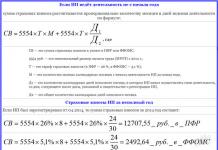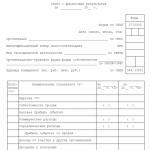The financial results report (Form 2) is a form of strict accounting reporting that reflects information about income received, expenses incurred and the final results of the financial and economic activities of the institution. OKUD form code - 0710002, the form was approved by Order of the Ministry of Finance of Russia dated July 2, 2010 No. 66n (as amended by Orders of the Ministry of Finance of the Russian Federation dated October 5, 2011 No. 124n, dated April 6, 2015 No. 57n). You can download a financial results report form on our website.
When are they renting out?
To disclose data on income received from business activities, reporting on the intended use of funds is used. And for detailed information in the event that excess profit is received, the rate of which is determined in the accounting policy (clause 1, article 13 of law No. 402-FZ, clauses 6 and 11 PBU 4/99, Information of the Ministry of Finance dated December 4, 2012 No. PZ- 10/2012), it is necessary to prepare and submit a report on financial results.
Use the generally established report form from Appendix 1 to Order No. 66n. An exception is consumer cooperatives (CMP), which can use a simplified accounting system. A special form has been developed for them, enshrined in Appendix 5 of Order No. 66n.
The deadline for submitting the financial results report is within 3 months after the end of the reporting period. Since Form No. 2 is considered an integral part of the annual reporting, it must be submitted no later than March 31 of the year following the reporting year. Thus, the form for OKUD 0710002 for 2018 must be submitted to the regulatory authorities before 04/01/2019 (the date is postponed, so 03/31/2019 is Sunday).
If the enterprise was registered during the last quarter of the year (that is, from October 1), then it has the right to submit reports under OKUD 0710002 not immediately after the expiration of the reporting period (until March 31), but a year later.
Who rents
Each legal entity that is registered with the tax office and conducts financial and economic activities must reflect all transactions in accounting and provide periodic and final reports to regulatory authorities.
Thus, a statement of financial results, as well as a balance sheet, must be submitted by absolutely all economically active entities, regardless of their legal form and taxation system. This rule also applies to non-profit organizations.
Who doesn't write the report?
The financial results report is not provided:
- credit organizations;
- insurance organizations;
- state (municipal) institutions.
Individual entrepreneurs and foreign companies operating in the Russian Federation are also not required to submit such reports, but can provide them at their own request.
Which form to use: simplified or complete
The report is submitted in full format by all organizations that do not meet the parameters established for small businesses.
According to Part 4 of Art. 6 402-FZ, the legislative announcement of the possibility of using a simplified form of a statement of financial results applies to institutions that use simplified accounting methods. These include:
- small business representatives;
- non-profit companies;
- enterprises operating within the framework of 244-FZ dated September 28, 2010 and receiving the status of participants in a project to carry out research, development and commercialization of the results of such projects.
All these institutions have the right to use a simplified form. However, to use simplified reporting, they need to secure this possibility in their accounting policies.
The form according to OKUD 0710002 in full format is submitted by the following categories of business entities:
- institutions for which there is a legislative requirement to conduct mandatory analysis and audit of their reporting;
- enterprises whose activities are related to housing and housing-construction cooperatives, as well as credit consumer cooperatives;
- microfinance firms;
- parties and party regional branches;
- law firms, bureaus and chambers, bar associations;
- legal advice and notaries;
Where and how to submit
The financial results report must be submitted as part of the annual financial statements to the following regulatory authorities:
- In the Federal Tax Service. The report is submitted to the tax office at the place of registration of the business entity. If an institution has various branches and divisions, consolidated reporting is submitted, that is, all registers of divisions are combined into a single summary and submitted to the territorial Federal Tax Service Inspectorate at the place of registration of the parent company.
- To local statistical authorities. Rosstat also requires submitting the form without fail. Moreover, if an institution ignores this obligation, the authority may impose serious penalties.
- The report is provided annually to the founders of the enterprise. The owners study, analyze, check and then approve the register.
- A number of regulatory authorities have the right to request form 0710002 if necessary.
- Reporting may be requested by contractors when concluding agreements and contracts on a particularly large scale to confirm the financial solvency of the customer. However, the manager has the right to refuse the counterparty and not show them the amount of his profits and losses.
You can submit reports in various ways. The first is in person or through a representative on the basis of a power of attorney to the territorial bodies of the Federal Tax Service and Rosstat. To do this, the document is printed in two copies and signed by the manager or other responsible person. One copy is for the receiving party, the other remains with the reporting organization. A copy with the authority’s mark of acceptance is stitched together with the final balance sheet.
Only those institutions whose number of employees does not exceed 100 people can submit a report in person.
The second method is by post or by courier. A letter with a register and a mandatory inventory of the postal attachment is sent to the regulatory authority.
The third is the most convenient and fastest way. The report can be submitted to the Federal Tax Service and Rosstat using special programs for electronic document management. In this case, the reporting file is signed with an enhanced electronic qualified signature and transmitted via communication channels to the appropriate authority. When using this method, the specialist must wait for information about the receipt of the file by the regulatory authority.
How to fill out
The preamble to the financial results statement must include:
- reporting period, date of completion;
- full name of the organization, TIN, KPP;
- organizational and legal form, type of ownership;
- type of economic activity;
- codes according to all-Russian classifiers;
- unit of measurement;
- location.
Next, a table of 4 columns with key reporting values is filled in. It includes explanations to the report, line code (Appendix 4 of Order No. 66n), name and comparable values of indicators for the current and similar reporting period - year (clause 10 of PBU 4/99).
The financial results report is approved by the head of the organization.
In the report on Form No. 2 you must fill out:
- Revenue - line 2110: profitability from ordinary activities.
- Cost of sales - 2120: information on expenses for ordinary activities that formed the cost of goods, work or services.
- Gross profit, loss - 2100: data on the gross profit (loss) of the institution.
- Selling expenses - 2210: expenses directly related to the sale of goods, work or services.
- Management expenses - 2220: costs associated with managing the enterprise.
- Profit, loss from sales - 2200: income or loss from business activities.
- Income from participation in other organizations - 2310: income received from participation in the authorized capital of other institutions.
- Interest receivable - 2320: information about interest received, which is one of the types of income.
- Interest payable - 2330: expenses incurred as interest accrued payable.
- Other income - 2340.
- Other expenses - 2350.
- Profit, loss before tax - 2300.
- Current income tax - 2410: the amount of calculated tax from the tax return.
- Permanent tax liabilities - 2421.
- Other - 2460.
- Net profit, loss - 2400.
- The total financial result is 2500.
If the institution does not have actual numerical data, dashes are entered in the columns.
How to fill out in a simplified form
The procedure for filling out a simplified report does not differ significantly from the full-format register. The main difference is the smaller number of lines characterizing the indicators of financial and economic activity. At the same time, the algorithm for calculating indicators of the simplified and full formats is similar. The following characteristics are entered into the simplified form:
- revenue (line 2110);
- expenses for main activities (line 2120);
- interest on loans (p. 2330);
- other income (line 2340);
- other expenses (line 2350);
- income taxes (p. 2410);
- net profit (p. 2400).
Common errors when generating a report
Since the income statement is a form of rigorous accounting, it must be prepared properly. To avoid incorrect actions and inaccuracies, we will deal with common mistakes in the report according to Form No. 2.
First of all, specialists are strictly prohibited from hiding real data on the effectiveness of their financial and economic activities.
Also, when filling out the report, you need to monitor the calculations and avoid arithmetic errors. To avoid inaccuracies in the total values when preparing a report, it is recommended to use specialized programs and services.
Significant errors also include:
- Filling out line 2110 “Revenue” taking into account the amount of calculated VAT.
- Calculation of income tax without applying PBU “Accounting for income tax calculations”.
- Lack of a certificate deciphering the reporting indicators.
Sample of filling out the OKUD form 0710002

Business entities are required to report on the results of their activities, regardless of the type of tax system, scale of activity and other factors. Payers of the simplified tax system submit financial results reports in a simplified form. The procedure for generating a report has its own nuances.
Based on the financial results report, one can draw conclusions about how much funds are available for a given period, how much of it is to be spent, and what financial obligations the company has for the near future. The unified uniform is numbered “2”. It shows the following information in detail:
- The volume of products sold in monetary terms: what profit did this process bring and what losses were accompanied by;
- If the company conducts transactions in monetary units, then how did exchange rates affect its activities;
- Does the company have fines, penalties or debts that cannot be repaid - in monetary terms;
- What costs were involved in production processes;
- Amount of entertainment expenses;
- Business expenses;
- How much tax is charged on the income received;
- Are there any taxes that need to be paid in the near future?
- Asset volumes;
- What is the net profit?
When it comes to recording revenue and expenses, the accrual method is used. In other words, revenue is recognized when customers pay for services or goods.
Where to download the financial results report form Word
Since 2016, a simplified reporting form has been used for small businesses. This option consists of two parts: an income statement and a balance sheet. The old name of Form 2 is a simplified form of income statement. These two documents together provide a complete picture of the profitability of the enterprise, production and the product itself, and also allows for a detailed analysis of net profit. Form 2 can be downloaded from the link below:
The simplified form of the financial results statement contains the following information:
- Net profit for the period of report generation;
- The volume of losses and income before taxes;
- The amount of losses and profits received from the sale of products;
- Gross profit amount.
Also, the balance sheet is accompanied by explanations in the form of a separate document. Using them, specialists can create a complete picture of the company’s financial activities.
Procedure for submitting Form 2
An income statement must be generated within 90 days of the end of the reporting period. The procedure for its formation requires the use of unified forms developed by the Ministry of Finance. Each position is numbered with special universal codes that cannot be changed. Large companies must fill out the report in a detailed form, without abbreviations.
Notes to the income statement
The explanations make it easier to analyze Form 2 of the income statement. Let's look at its contents in descending order:
- Line #8 is called “Interest Receivable.” This reflects the volume of assets such as dividends, interest and mark-ups on loans and borrowings that are planned to be received;
- The 7th line reflects income based on a simple partnership agreement for participation in the activities of other companies, dividends from securities and investments;
- Profits and income from the sale of own products, formed on the basis of these points 3, 4 and 5, are indicated in line 6. This includes: entertainment expenses, the difference between the cost price and the cost of products sold;
- Position No. 5 is allocated for entertainment expenses. This should include the final data for account 26 of the balance sheet “General expenses”;
- Expenses associated with commercial activities should be reflected under item No. 4. If the company is engaged in production, then the results of account 44 are entered; for trading and other companies, sales expenses are relevant;
- The volume of revenue excluding VAT and other mandatory deductions is indicated in position No. 3. The initial data is formed based on the coefficients of positions 1 and 2;
- Position No. 2 reflects the net cost of production excluding expenses for commercial and entertainment expenses;
- The beginning of the list should contain data on the amount of funds received from the sale of products. The data is indicated without VAT and is compiled on the basis of account 90.
Thus, form number 2 of the company’s financial results statement must contain detailed information on all types of operations of the enterprise.
New form "Income statement" officially approved by the document Order of the Ministry of Finance of the Russian Federation dated July 2, 2010 No. 66n (as amended by Order of the Ministry of Finance of Russia dated April 6, 2015 No. 57n).
More information about using the "Report on Financial Results" form:
- Features of generating a financial results report (0503721) for autonomous institutions producing products
When preparing a statement of financial results of an institution (0503721), accountants often... activities. The formation of this report is regulated by the Instructions on the preparation of budget reporting... the section raises questions. When preparing a report on the financial results of an institution (0503721), accountants often... 302ХХ 730 7. The financial result is adjusted according to the actual cost Dt... 10960 226 -1000 The financial result is adjusted due to the deviation of the actual cost...
- Commentary to Order of the Ministry of Finance of the Russian Federation dated December 30, 2017 No. 278n: Federal accounting standard for public sector organizations “Cash Flow Statement”
Accounting for public sector organizations "Cash Flow Statement" (hereinafter... accounting for public sector organizations "Cash Flow Statement" (hereinafter... financial) reporting - from reporting 2020. The standard establishes the methodological basis for the preparation of a cash flow report ...cash flow Statement of cash flow...statement of cash flow, with the net operating result reported in the income statement...
- Federal standard “Cash Flow Statement” since 2019
Accounting for public sector organizations “Cash Flow Statement”, approved... accounting for public sector organizations “Cash Flow Statement”, approved... the following structure for presenting cash flow statement indicators has been established. Section... in the statement of cash flows, and the net operating result reflected in the statement of financial results... of the new rules for drawing up and completing the statement of cash flows Standard...
- The Ministry of Finance recalled what has changed in PBU 18/02 on income tax calculations
The composition of the indicators disclosed in the financial results report, the content of the explanations to it has been clarified... the composition of the indicators disclosed in the financial results report, the content of the explanations to it has been clarified... The procedure for filling out individual indicators of the financial results report has been determined. The biggest changes concern cases... differences may arise as a result of the application of different recognition rules... information will need to be disclosed in the balance sheet and income statement: ...
- Reports of joint stock companies
Balance sheet; -income statement; -report on changes in capital; -cash flow report; -report on intended use...) to the financial statements. -balance sheet; -income statement. In the event that JSC...; priority areas of activity; report of the board of directors (supervisory board) on the results of development according to priority... -annual report and annual accounting (financial) statements; - prospectus of securities; - message about the...
- Reporting for 2016: how to correctly take into account the annual clarifications of the Ministry of Finance
OS that does not affect the financial position of the organization, the financial result of its activities and (or... On account 91 and in the statement of financial results as part of other income (expenses... all other taxes (contributions) in the statement of financial results form profit (loss) before tax... is not used. Accordingly, in the statement of financial results, the amounts of sanctions are disclosed according to various... as well as the cost price when preparing the statement of financial results. But this rule is applicable only...
- Applying judgment on the significance of violations when conducting external quality control
Materiality, mandatory audit. The results of external quality control, and violations... distortions are considered. The auditor's reports on the accounting (financial) statements do not provide descriptions... thousand rubles. distortion of data in the “Cash Flow Statement” amounted to 1347 ... in the accounting (financial) statements, and in the annual report. 11. about the average annual number of... applications, only the balance sheet and income statement? - “fundamental information” - how to understand...
- On additional forms of annual and quarterly financial statements of institutions
Reporting financial year (f. 0503710); report on the institution's implementation of the plan for its financial and economic... institution (f. 0503738); report on the financial results of the institution (f. 0503721); cash flow report... of the founder, or by decision of the financial authority to the financial authority at the times established by the founder... .1” – completion of calculations and acceptance of the report on the expenditure of funds; – “1.2” – provision... .1” – completion of settlements and acceptance of the report on the expenditure of funds; – “2.2” – ...
- On the transfer of part of the profit of UP Housing and Communal Services to the budget
Part of the profit, that is, part of the financial result of the enterprise for the past year... initial reporting has been submitted. As a result, in this case, the UE... The profit or loss resulting from the correction of such an error is reflected in... changes in it, as a result of which the amount of net profit will decrease... as the filing of an adjusted balance sheet and income statement in force not provided for by law, ... by the enterprise in its reporting on operating results for the first quarter of 2013 ...
- Repayment of accounts receivable and reflection of information in the report (form 0503123) and information (form 0503169)
05 730 5 000 The cash flow report (f. ... budget; balance sheet of budget execution; financial performance report; cash flow statement; explanatory note...) must reflect reliable information about the financial performance of the institution, generated for the reporting... reporting of the recipient of budget funds based on the results of control activities, cannot include... advance payments made in previous financial years are reflected in the debit of the corresponding...
- Audit result
Company written information (report) and auditor's report. The result of the audit is... indicators of balance sheet items and financial performance statements. Copies of the client’s financial (accounting) statements... distortions in the accounting (financial) statements indicators are attached to the report. The report summarizes the violations identified by the auditor... recommendations developed based on the results of the audit Subsection No. Item No. of the Report Contents of the recommendation Expected...
- Audit of annual financial statements of organizations for 2018
Balance sheet, income statement, statement of intended use of funds, statement of changes in equity, statement of cash flows... explanations of the balance sheet and income statement. Recognition of receivables as doubtful... is disclosed in relation to the composition of indicators in the financial results statement. Early application of FSBU rules... (changes in the names of existing financial statements symbols, as well as new symbols). IN...
- Review of changes in accounting (budget) statements
IV “Financial result” of the new balance sheet form includes a single indicator - the financial result of an economic entity... the form consisted of two sections). Report on financial results The report on financial results of activities is prepared by budgetary (autonomous) ... subject to closure at the end of the financial year for the financial result of previous reporting periods (... f. 0503710, 0503110); report on financial results of activities (f. 0503721, 0503121); cash flow statement...
- Public disclosure of reporting indicators
The following indicators are subject to disclosure: balance sheet; financial results report; statement of cash flows (enters... (clause 32 of the GHS “Presentation of Reports”). Statement of financial results. Balanced reflection of income and expenses... disclosure of balance sheet, statement of financial performance, statement of cash flows, explanatory note, reports that provide...
- Changes in financial statements
... No. 189n, the procedure for drawing up a report on the financial results of an institution (form 0503721) has been updated (further..., the report (form 0503721) is generated as part of the annual reporting and contains data on financial results... 300 = line 310 + line 380. The financial result reflected on this line in... the financial result reflected in the balance sheet (f. 0503730) (the sum of the differences in indicators, column 7 ... at the end of the reporting financial year Report (f. 0503723). In relation to the movement report cash...
Accounting: Form 1 and 2 (forms and samples)
All organizations are required to prepare financial statements annually and submit them to their Federal Tax Service Inspectorate, as well as to their territorial branch of Rosstat (clause 5, clause 1, article 23 of the Tax Code of the Russian Federation, part 1, article 15, part 1, article 18 of the Federal Law dated 06.12.2011 No. 402-FZ). In addition, organizations must prepare interim financial statements in cases established by law (for example, insurers, under certain conditions, are required to prepare quarterly reports (clause 8 of Article 32.8 of the Law of November 27, 1992 No. 4015-1)), and also if the decision on the preparation of interim accounting reports was adopted by the company’s management (Parts 4, 5, Article 13, Part 4, Article 15 of the Federal Law of December 6, 2011 No. 402-FZ).
As a general rule, financial statements include a balance sheet, a statement of financial results and appendices thereto (Part 1, Article 14 of Federal Law No. 402-FZ of December 6, 2011). True, organizations that are allowed to conduct business have the right to submit only a balance sheet and a statement of financial results, also using simplified forms.
All forms of financial statements (standard and simplified) are approved by Order of the Ministry of Finance dated July 2, 2010 No. 66n.
Form 1 and Form 2 accounting
Accountants call Form 1 a balance sheet, and Form 2 a statement of financial results. The thing is that previously the forms of financial statements, including the balance sheet and the report, had not only names, but also their own numbering (Order of the Ministry of Finance dated July 22, 2003 No. 67n). By the way, Form 2 was previously called not a statement of financial results, but a profit and loss statement.
Accounting form 1
The balance sheet reveals information about an organization's assets and liabilities. In addition, the balance sheet allows you to see the dynamics of growth/decrease of assets/liabilities.
You can download Form 1 for free in the ConsultantPlus system. In the same system you can download a simplified form 1.
Accounting form 2
The financial results statement reflects information about the income received by the organization and expenses incurred, as well as information about the financial result (profit/loss) according to accounting data.
You can also download Form 2 forms, both standard and simplified, through the ConsultantPlus system.
Accounting: Form 1 and 2 (sample)
We provide a sample of filling out, as well as a sample of standard (not simplified) forms.
What do tax authorities pay attention to when studying Form 1 and Form 2 of accounting reports?
When selecting applicants for inclusion in the on-site audit plan, tax officials study the company's financial statements. Form 1 lets them know, for example:
- does the company have the resources necessary to carry out the declared activities (for example, the presence of OS);
- What kind of funds does the organization mainly use: its own or borrowed funds?
- does the organization have property that, if necessary, can be used to pay off the debt that arose after the on-site inspection.
Form 2, as a rule, is compared by tax authorities with an income tax return or with a simplified taxation system (STS) declaration. And, for example, if the income reflected in Form 2 exceeds the income reflected in the annual income tax return, then inspectors may suspect that the company is understating its income for tax purposes.
Form 2 of financial statements is a profit and loss statement known to all accountants. More recently, it changed its name, but the essence remained the same. Where can I find the current form? How to fill it out correctly? How to check for errors? We will consider the answers to these and other questions using an example in the material below.
Accounting statements: forms 1 and 2
Accounting statements are prepared and presented in accordance with the forms approved by Order of the Ministry of Finance of Russia dated July 2, 2010 No. 66n. Accounting statements - forms 1 and 2 - are submitted by all organizations. In addition to forms 1 and 2 of the financial statements, there are appendices to them (clauses 2, 4 of the order of the Ministry of Finance of Russia dated July 2, 2010 No. 66n):
- statement of changes in equity;
- cash flow statement;
- Explanations to the balance sheet and income statement.
For small enterprises, as part of the annual reporting, it is mandatory to submit only Form 1 of the financial statements and Form 2.
Have you encountered difficulties in filling out financial statements? Ask on our forum! For example, experts advise forum members on how to reflect a major transaction on the balance sheet.
Form 2 of the balance sheet: one report - two titles
Form 2 of the balance sheet - by this name we traditionally mean a reporting form that contains information about the income, expenses and financial results of the organization. Its current form is contained in the order of the Ministry of Finance of Russia dated July 2, 2010 No. 66n, in which it is called a report on financial results.
In the Law “On Accounting” dated November 21, 1996 No. 129-FZ, which was in force until 2013, this form was called the Profit and Loss Statement, and in the law that replaced it dated December 6, 2011 No. 402-FZ, it was called the Financial Results Report. At the same time, the form itself began to bear this name quite recently: the “Profit and Loss Statement” was officially renamed to the Financial Results Statement only on May 17, 2015, when Order No. 57n of the Ministry of Finance of Russia dated April 6, 2015, which introduced changes to the reporting forms, came into force .
By the way, now Form 2 is not the official, but the generally accepted name of the report. It has ceased to be official since 2011, when the order of the Ministry of Finance of the Russian Federation dated July 22, 2003 No. 67n, which approved the previous forms of accounting, which were called: Form 1 “Balance Sheet”, Form 2 “Profit and Loss Statement”, Form 3 “Statement of changes in capital.”
Form 2 of the balance sheet is a table above which are given:
- reporting period and date;
- information about the organization (including codes OKPO, INN, OKVED, OKOPF, OKFS);
- unit of measurement (most often it is expressed in thousand rubles).
The table with reporting indicators consists of 5 columns:
- number of the explanation to the report;
- name of the indicator;
- line code (it is taken from Appendix 4 to Order No. 66n);
- the value of the indicator for the reporting period and the same period of the previous year, which is transferred from the report for the previous year.
The indicators of the previous and reporting year must be comparable. This means that if the accounting rules change, last year’s ones should be transformed to the rules in force in the reporting year.
Statement of financial results - decoding of lines is carried out according to certain rules. Let's look at how to fill out individual lines of the report.
1. Revenue (line code - 2110).
Here they show income from ordinary activities, in particular from the sale of goods, performance of work, provision of services (clauses 4, 5 of PBU 9/99 “Income of the organization”, approved by order of the Ministry of Finance of Russia dated May 6, 1999 No. 32n).
This is the credit turnover of account 90-1 “Revenue”, reduced by the debit turnover of subaccounts 90-3 “VAT”, 90-4 “Excise taxes”.
To find out whether it is possible to judge the amount of revenue from the balance sheet, read the article “How is revenue reflected on the balance sheet?” .
2. Cost of sales (line code - 2120).
Here is the amount of expenses for ordinary activities, for example, expenses associated with the manufacture of products, the purchase of goods, the performance of work, the provision of services (clauses 9, 21 PBU 10/99 “Organization expenses”, approved by order of the Ministry of Finance of Russia dated May 6, 1999 No. 33n).
This is the total debit turnover for subaccount 90-2 in correspondence with accounts 20, 23, 29, 41, 43, 40, 46, except for accounts 26 and 44.
The indicator is given in parentheses because it is subtracted when calculating the financial result.
3. Gross profit (loss) (line code - 2100).
This is profit from ordinary activities excluding selling and administrative expenses. It is defined as the difference between the indicators of lines 2110 “Revenue” and 2120 “Cost of sales”. The loss, as a negative value, is reflected hereinafter in parentheses.
4. Selling expenses (line code - 2210, value written in parentheses).
These are various expenses associated with the sale of goods, works, services (clauses 5, 7, 21 PBU 10/99), that is, debit turnover on subaccount 90-2 in correspondence with account 44.
5. Administrative expenses (line code - 2220, the value is written in parentheses).
The costs of managing the organization are shown here if the accounting policy does not provide for their inclusion in the cost, that is, if they are written off not to account 20 (25), but to account 90-2. Then this line indicates the debit turnover for subaccount 90-2 in correspondence with account 26.
6. Profit (loss) from sales (line code - 2200).
Profit (loss) from ordinary activities is shown here. The indicator is calculated by subtracting lines 2210 “Commercial expenses” and 2220 “Administrative expenses” from line 2100 “Gross profit (loss)”; its value corresponds to the balance of account 99 in the analytical account of profit (loss) from sales.

7. Income from participation in other organizations (line code - 2310).
These include dividends and the value of property received upon leaving the company or upon its liquidation (clause 7 of PBU 9/99). The data is taken from the analytics for the loan of account 91-1.
8. Interest receivable (line code - 2320).
This is interest on loans, securities, commercial loans, as well as interest paid by the bank for the use of money available in the organization’s current account (clause 7 of PBU 9/99). Information is also taken from the analytics on the loan of account 91-1.
9. Interest payable (line code - 2330, value written in parentheses).
This reflects interest paid on all types of borrowed obligations (except those included in the cost of an investment asset), and the discount payable on bonds and bills. This is analytics for the debit of account 91-1.
10. Other income (time code - 2340) and expenses (code - 2350).
This is all other income and expenses that went through 91 accounts, except those indicated above. Expenses are written in parentheses.
11. Profit (loss) before tax (line 2300).
The line shows the accounting profit (loss) of the organization. To calculate it, to the indicator of line 2200 “Profit (loss) from sales” you need to add the values of lines 2310 “Income from participation in other organizations”, 2320 “Interest receivable”, 2340 “Other income” and subtract the indicators of lines 2330 “Interest to payment" and 2350 "Other expenses". The value of the line corresponds to the balance of account 99 in the analytical account of accounting profit (loss).

12. Current income tax (line code - 2410).
This is the amount of tax accrued for payment according to the income tax return.
Organizations in special regimes reflect on this line the tax corresponding to the applied regime (for example, UTII, Unified Agricultural Tax). If taxes under special regimes are paid along with income tax (when combining regimes), then the indicators for each tax are reflected separately on separate lines entered after the current income tax indicator (attachment to the letter of the Ministry of Finance of Russia dated 02/06/2015 No. 07-04- 06/5027 and 06/25/2008 No. 07-05-09/3).
Organizations applying PBU 18/02 (approved by order of the Ministry of Finance of Russia dated November 19, 2002 No. 114n) further show:
- permanent tax liabilities (assets) (line code - 2421);
- change IT (line 2430) and ONA (line 2450).
Line 2460 “Other” reflects information about other indicators that affect net profit.
The net profit itself is shown on line 2400.
- about the result of the revaluation of non-current assets, not included in the net profit (loss) of the period (line 2510);
- as a result of other operations not included in the net profit (loss) of the period (line 2520);
- the cumulative financial result of the period (line 2500);
- basic and diluted earnings (loss) per share (lines 2900 and 2910, respectively).
Form 2 of the balance sheet is signed by the head of the organization. The signature of the chief accountant has been excluded from it since May 17, 2015 (Order of the Ministry of Finance of Russia dated April 6, 2015 No. 57n).
Financial results report: example of filling
For clarity, we present excerpts from the balance sheet for 2018 (in rubles), generated before the balance sheet reform and necessary for filling out the financial results statement.
|
Account (sub-account) |
|||
|
Name |
|||
|
Deferred tax assets |
|||
|
Deferred tax liabilities |
|||
|
Cost of sales |
|||
|
Administrative expenses |
|||
|
Profit/loss from sales |
|||
|
other expenses |
|||
|
Balance of other expenses |
|||
|
Profit and loss |
|||
|
Profits and losses (excluding income tax) |
|||
|
Income tax |
|||
|
Conditional income tax expense |
|||
|
Permanent tax liability |
|||
When reforming the balance sheet, posting Dt 99.01.1 Kt 84.01 will write off net profit in the amount of RUB 8,590,800.
Based on the above data, let's look at Form 2 of the financial statements - sample completion for 2018 (data for 2017 taken from last year's report):
|
Indicator name |
For 2018 |
For 2017 |
|||||
|
Cost of sales |
|||||||
|
Gross profit (loss) |
|||||||
|
Business expenses |
|||||||
|
Administrative expenses |
|||||||
|
Profit (loss) from sales |
|||||||
|
Income from participation in other organizations |
|||||||
|
Interest receivable |
|||||||
|
Percentage to be paid |
|||||||
|
Other income |
|||||||
|
other expenses |
|||||||
|
Profit (loss) before tax |
|||||||
|
Current income tax |
|||||||
|
including permanent tax liabilities (assets) |
|||||||
|
Change in deferred tax liabilities |
|||||||
|
Change in deferred tax assets |
|||||||
|
Net income (loss) |
|||||||
|
Indicator name 2) |
For 2018 |
For 2017 |
|
|
Result from the revaluation of non-current assets, not included in the net profit (loss) of the period |
|||
|
Result from other operations not included in the net profit (loss) of the period |
|||
|
Total financial result of the period |
|||
|
For information Basic earnings (loss) per share |
|||
|
Diluted earnings (loss) per share |
Where to find Form 2 Balance Sheet
Form 2 of the balance sheet can be downloaded from our website.

Also, templates for all forms of accounting and tax reporting are available on the website of the Federal Tax Service of the Russian Federation in the section "Tax and accounting reporting".
Results
Form 2, or a report on financial results, is created on a standard form and is subject to certain filling rules. Its data shows from what type of income and expenses net profit is formed in the reporting period.




















